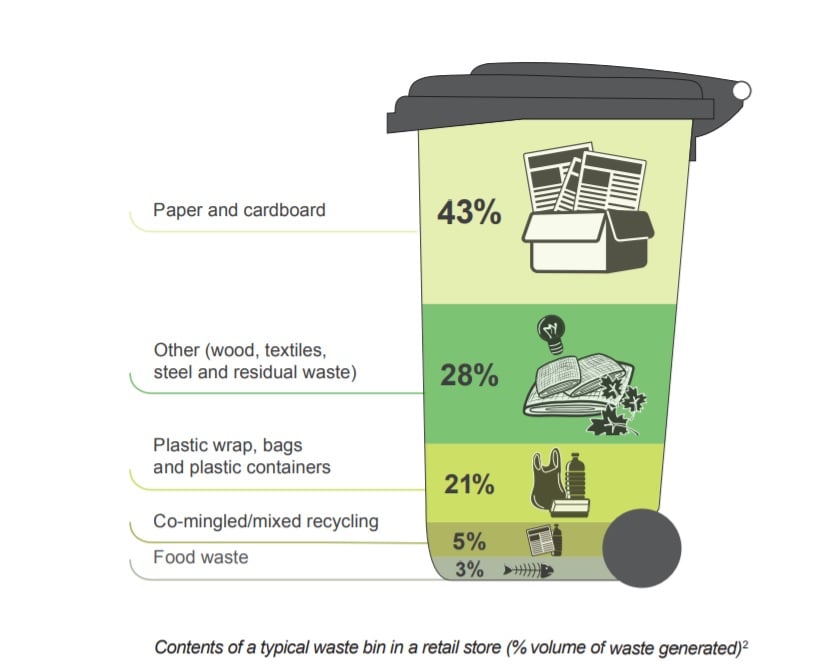
Retail Waste Management 🛒 – Tips For Waste And Recycling For Shops
Retail Waste Management 🛒: The Australian retail sector has gone through some tough years with the global financial crisis and reduced consumer sentiment as well as the increase in ordering online through companies like Amazon. If that was not bad enough, the start of 2020 was an incredible shock with the Government restrictions implemented from March onwards.
>>Download Now: Free PDF Business Owners Guide To General Waste Bin Services
Thankfully, we see more and more businesses reopen and customers starting to make visits to their local shopping centres and retail precincts again.
However, retail and shopping are still the backbone of the economy and with the diverse range of goods sold and shops. It thankfully will always remain so. In this short blog we cover some of the key facts about retail outlets (or shops in plain English!) and their waste streams, and of course, how to reduce your costs, boost recycling and get flexible services into the bargain.
We will cover topics such as reducing waste in retail store operations, which can help your bottom line and also options for how to reduce food waste in retail.
Retail waste management: you should be recycling most of your waste to reduce costs
When we look at retail waste statistics and reducing waste in retail store operations, we need to accept that the sector creates an awful lot of waste!
Some retail waste statistics are shocking, such as:
- Between 2000 and 2014, clothing production doubled with the average consumer buying 60 per cent more pieces of garment compared to 15 years ago. Yet, each clothing item is now kept half as long.
- NPR reports, from the Environmental Protection Agency, that 15.1 million tons of textile waste were generated in 2013, of which 12.8 million tons were discarded.
- About 15% of fabric intended for clothing ends up on the cutting room floor. This waste rate has been tolerated industry-wide for decades.

What about the good news?
Okay, so if those retail waste statistics are bad news, there is also good news. And, that is that retail management waste industry solutions have advanced a lot in recent years. Most retail shops or shopping centres can recycle a very large amount (and in some cases all) of their waste!
The NSW EPA has produced a useful fact sheet on retail waste management. You can find the document here.
The downloadable PDF document covers lots of great retail waste statistics from an Australian perspective and also lots of ways to boost recycling in a retail store and reduce waste in retail store operations.
Key points from the document include:
Key points
“Each year a typical retail store generates 7.5m3 of waste per employee and up to 1.7m3 of waste for every 1m2 of floor space.
“Retailers in NSW could collectively recycle an extra 31,665 tonnes of plastic and 35,937 tonnes of paper each year. This would fill 2.3 million shopping trolleys with plastic and 1.5 million shopping trolleys with paper each year.
“Sort through the contents of a typical waste bin in a retail store and you will find that 94 per cent is filled with packaging materials like paper, cardboard and plastic (polystyrene packaging), almost all of which can be recycled.
“By putting this huge volume of material in the correct recycling bins, your business could reduce its waste collection charges and save money. You can also recycle the smaller amounts of metal and leftover food in your bins, perhaps sharing recycling containers with nearby businesses.
“Research by the Department has shown that each full-time employee in a retail outlet in New South Wales generates between 0.7 and 4.4kg of waste per day. You may be able to reduce your waste by 90 per cent, not only benefiting your business but also the environment.”
The NSW EPA also provides indicates average waste compositions for retail waste disposal (general solid waste). Obviously, this will vary depending on the business type:
Average
– Paper and Cardboard – 48%
– Plastic – 46%
– Metals – 1%
– Food waste – 2%
– Other – 3%

From this breakdown, we can see that with very little effort an average retail shop could recycle c. 90% plus of its waste with an effective retail waste management plan. The vast majority produced is recyclable materials and implementing a smart recycling program can be cost-effective and reduce disposal costs.
After the implementation of a recycling plan (retail waste management plan), the amount of waste going to landfill will be greatly reduced and general waste reduction will result in a cost decrease.
Whether you are in a shopping centre or a high street store, recycling will cut costs, reduce your carbon footprint and help you appeal to new customers.
Check out our recent blog on options for recycling running shoes as an example of innovative retail industry waste management.
Does your retail outlet also produce food waste? How to reduce food waste in retail?
Whilst the info above suggests low levels of food waste in retail – you may be asking how to recycle food waste or reduce food waste in retail generally.
Your business may produce a minimal amount of food waste such as from a lunch room or larger amounts of waste. If you are asking how to reduce food waste in retail settings, we are here to help. Give us a call to discuss your food waste options or check out blogs such as this one on food waste bin options.
How Waster can help you reduce your spending, increase recycling and say goodbye to lock-in contracts
Waster works with thousands of small and medium businesses such as retail industry operators. We help companies from shopping centres to standalone retail outlets boost recycling, reduce retail waste going to landfill and cut costs.
Waster offers all recycling and waste services on flexible 30-day agreements to small and medium business customers throughout Australia. Additionally, you do not need to sign a long-term, restrictive contract and can enjoy the freedom of flexibility alongside low prices and first-rate customer service. You can also find out about waste management in pubs and clubs as well as waste services in hotels and motels.
Conclusion on retail waste management
A retail store can aim to recycle the vast majority of waste produced. It can also hit 80-90 per cent recycling.
If you have large amounts of cardboard waste, recycling can even provide rebates in large-enough quantities. Check out our blog on baler and compactor options here.
At Waster, we encourage companies to also use their recycling performance for marketing purposes and especially in retail waste management where customers have lots of choices on where they spend their dollars!
Check out our blog on waste management fees.

Leave a Reply Cancel reply


